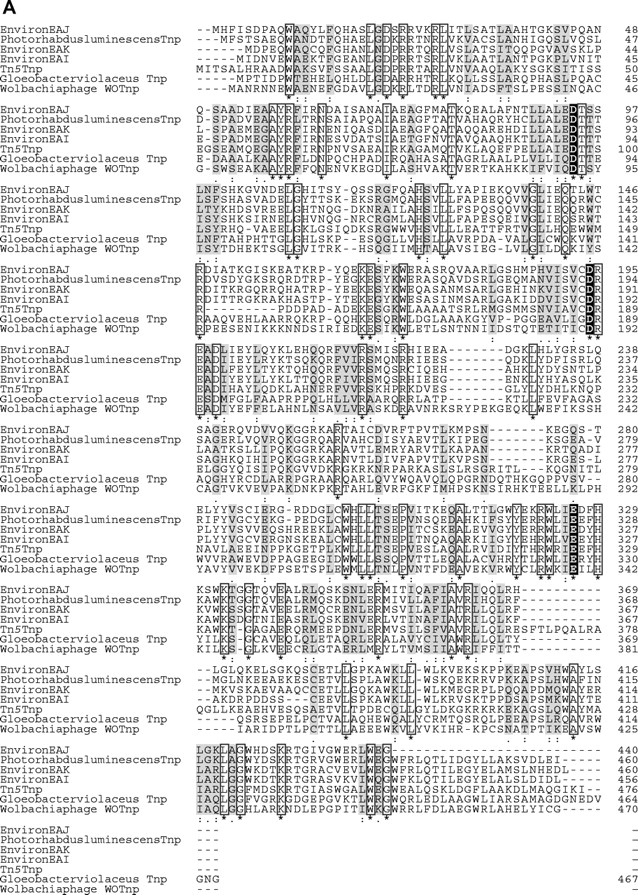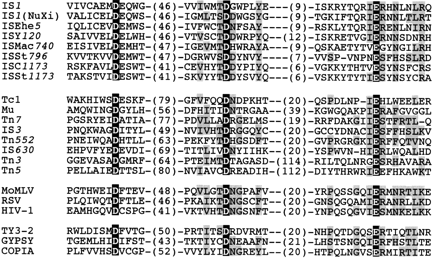
Davidson College Molecular Biology
Orthologs of Transposase

Active site of Tn5 Transposase (Davies et al., 2000).
What is an ortholog...?
Genes with a common ancestor are known as homologs. Homologs can be further divided into orthologs and paralogs. Paralogs are genes that are in the same or different species due to gene duplication events. Orthologs are genes found in different species and whose divergence can be traced to the speciation events that gave rise to the different species (Sadava et al., 2008).
A review of the function of transposase...
Transposase (Tnp) is the enzyme responsible for excising and inserting donor DNA into a target DNA sequence. Tnp recognizes specific DNA sequences, which tell it where to excise and insert. Tnp nicks both the 3’ and 5’ ends of DNA and forms new phosphodiester bonds. It is a multifunctional protein and contains a crucial catalytic region. Within the catalytic region one or two divalent metal ions (either Mn2+ or Mg2+) help coordinate the nicking and bond formation. In the Tn5 Tnp of E. coli three amino acids, aspartic acid, aspartic acid, and glutamic acid (DDE) ligand with the divalent metal ions. (Click Here For Further Review)
Transposase beyond E. coli...
If the DDE motif is mutated in any manner transposition does not occur. Each amino acid residue is required perform every single catalytic step. DDE is necessary for the catalytic action of Tn5 Tnp in E. coli (Peterson et al., 2002). Thus, it would logically follow that the DDE motif is highly conserved across species…and it is. A BLAST Protein Alignment (Figure 1) of the Tn5 Tnp of ten bacteria shows the DDE motif to be present across all ten species. It also shows a highly conserved arginine residue. While not part of the DDE motif, Arg does seem to play a role in the enzyme’s action. If Arg is mutated, Tn5 Tnp function does not cease, but it does decline (Davies et al., 2000).


Figure 1. Sequence alignment of the Tn5 Tnp of multiple species. Note the red conserved residues including the DDE motif (NCBI).
Reznikoff et al. conducted a similar investigation of the Tn5 Tnp of E. coli. They found (Figure 2) six additional species containing the DDE motif as well as other highly conserved residues, including a DTT motif, a DREAD motif, and a YREK motif. Only the DTT motif has been shown to play a role in enzyme function. It contacts the target DNA recognition end sequence (Reznikoff et al., 2004).

Figure 2. Sequence analysis of Tn5 Tnp's across species. Environ EAJ, EAK, and EAI are all organisms isolated in the Sargasso Sea Sequencing project. Tn5Tnp is from E. coli. Completely conserved residues are boxed and chemically conserved residues are shaded grey. Note the DDE motif in black (Reznikoff et al.,2004).
Other types of transposase...
Transposases are not limited to the Tn5 family. There are multiple types of transposons within species and across species. However a conserved domain is the DDE motif. Tn3, Tn7, and Tn10 all have the DDE motif (Figure 3) as well as the phage Mu transposase, the integrases of HIV-1, RSV, and MoMLV, and the retrotransposons Ty3-2, Gypsy, and Copia (Ohta et al., 2002), (Bolland et al., 1996).

Figure 3. Sequence analysis of transposases, integrases, and retrotransposases. Note the DDE motif in black (Ohta et al., 2002).
In all of these cases, the conservation of the DDE motif shows the conservation of function. The DDE motif is necessary for coordination with the divalent metal ion in order for the transposase to nick and insert DNA. Within eukaryotes the DDE motif has been considered absent. However, in the hAT class of transposons found in C. elegans and the housefly, a conserved DSE motif exists. The S residue does not seem to be related to the catalytic function though. Only mutations to the D and E residues prevent transposition (Michel et al., 2002).
Final Thoughts
Transposases exist beyond the Tn5 Tnp found in E. coli. They are present throughout bacteria, viruses, and eukaryotes. Also present seems to be a specific amino acid motif within the catalytic region. This DDE (or DSE) motif is necessary for the coordination with a divalent metal ion and the actual enzyme function. Thus, even as species have diverged this motif has been maintained within the different transposases. Even more important is the overwhelming number of different species with transposase. Such a high number show the evolutionary importance of jumping genes.
References
1. Bolland, S, Kleckner, N. 1996 Jan. The three chemical steps of Tn10/IS10 transposition involve repeated utilization of a single active site. Cell; 84 (2): 223-233. (PubMed)
2. Davies, DR, Goryshin, IY, Reznikoff, WS, Rayment, I. 2000 July. Three-dimensional structure of the Tn5 synaptic complex transposition intermediate. Science; 289 (5476): 77-85. (PubMed)
3. Michel, K, O’Brochta, DA, Atkinson, PW. Does the proposed DSE motif form the active center in the Hermes transposase? Gene; 298 (2): 141-146. (PubMed)
4. Ohta, S, Tsuchida, K, Choi, S, Sekine, Y, Shiga, Y, Ohtsubo, E. 2002 Nov. Presence of a characteristic D-D-E motif in IS1 transposase. Journal of Bacteriology; 184 (22): 6146-6154. (PubMed)
5. Peterson, G, Reznikoff, W. 2003 Jan. Tn5 transposase active site mutations suggest position of donor backbone DNA in synaptic complex. Journal of Biological Chemistry; 278 (3); 1904-1909. (PubMed)
6. Reznikoff, WS, Bordenstein, SR, Apodaca, J. 2004 Dec. Comparative sequence analysis of IS50/Tn5 transposase. Journal of Bacteriology; 186 (24); 8240-8247. (PubMed)
7. Sadava D, Heller HC, Orians GH, Purves WK, Hillis DM. 2008. Life: The science of biology. 8th ed. Sunderland (MA): Sinauer Associates; 1251 p.
Davidson College Molecular Biology
Questions? Comments? E-mail Bobby DesPain